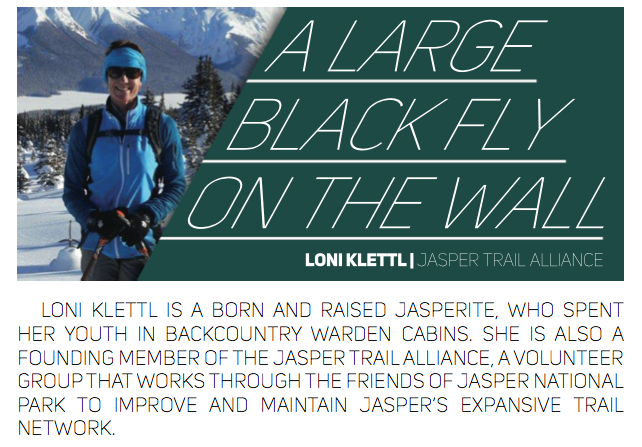 Jasper National Park’s human history is full of remarkable individuals. This breed of unique, distinctively “true mountain souls”always surfaces when most needed. Their gift is the courage to see near-invisible cracks in the norm. They have the ability to spot light through these fissures and look into new and different realities. These opportunists and visionaries open the doors for wilderness lovers by speaking up, challenging and asking, “Why not?” and explaining, “This is why this is a good idea and if you don’t agree, we’ll prove it.”
Jasper National Park’s human history is full of remarkable individuals. This breed of unique, distinctively “true mountain souls”always surfaces when most needed. Their gift is the courage to see near-invisible cracks in the norm. They have the ability to spot light through these fissures and look into new and different realities. These opportunists and visionaries open the doors for wilderness lovers by speaking up, challenging and asking, “Why not?” and explaining, “This is why this is a good idea and if you don’t agree, we’ll prove it.”
This is a story of Curly Phillips, Joe Weiss and brothers Verne and Doug Jeffrey, four such visionaries hunkered around the wood stove’s radiating warmth in Shangrila Cabin. They were high up in the Maligne Valley, nestled discreetly below Sunset and Lovat Peaks and, the glory bowl of them all, the Snowbowl.
After a great day of skiing eventually one must say, “That’s enough” and leave the Snowbowl’s addictive snowfields and the runny nose of Aberhart to retire to the porch of Shangrila to recover wits and legs. They inhaled their beef stew, the “feedbag was on,” food being simply fuel to stoke the engine for another day.
After evening chores—dishes done, creek water hauled in, wood stacked stove side—the men were feeling their age. It wasn’t spoken of; pride and dignity silenced their tongues. They leaned in closer to the fire, its heat loosening cricked backs and stiff joints, hammered and inflamed after decades living and working outside.
Storytelling camaraderie strengthens the chink of log walls and the tales circled around, memories and emotions attached to the ski Mecca they had created, as well as those who’d enjoyed their world, cabin and vision. Miraculously (since this species of insect cannot survive in winter) there was a large black fly privy to it all. He couldn’t believe this opportunity, and thought, “I’m such lucky fly.”
Tucked up against the cabin wall near the hissing lantern, the fly crouched, straining so as to not miss a word, taking in these legends from the 1930s—Jasper’s ski pioneers. Fuelled by their camaraderie of shared vision and the euphoria of youth, they’d had the eyes to recognize what would astound the ski world of their time: a hut-to-hut possibility that included Watchtower, Shangrila, then on toward Maligne Pass.
Mesmerized was the fly as the four recalled their many recons into the flawless, beating heart of the Maligne Valley. He commiserated with their frustrations, laughed inwardly at their jokes and marvelled in their snow dreams. The ideal cabin location required access, incredible terrain, plentiful snow, water and beauty. The long winter outings spent searching often saw ferocious conditions, leaving the men hunkered down under a generous fir, freezing in wet clothing.
Nothing deterred these tough, motivated men, often oblivious to hardships and discomfort. They’d concoct a tasty soup from river water, spruce tips and a round stone and would eat the soles of their boots, if need be. They were the ultimate endurance athletes.
Eventually their mood changed, the banter quieted and the men looked to the flames. “This is not good,” thought the fly. As they gazed deep into the molten guts of the fire, the anguish that festered in their own guts awakened. The truth comes out as the fire burns low. Strong words: “delayed winter access.” The words mean as much to visionaries as the action means for caribou.
Hopefully one day, in Maligne’s high alpine, we will again spot more of that elusive creature so indicative of wild spaces; the caribou with curious brown eyes reflecting the incredible challenges of survival.
The lack of winter-time smoke from Shangrila’s chimney tells of cold, silver-blue ashes that whisper of loneliness, despair. The black fly lies on its back, legs curled in death. Those ski visionaries are gone, their blissful visions dashed. They lived, dreamed and skied in simpler times. Today’s world, and caribou conservation obligations, has driven the last ski pole into the Maligne Valley’s many hearts.
Or has it? If you’ve been lucky, you’ve seen a man that made you stop in your tracks. He’s been shadowing your turns, schussing around trees, mimicking your actions. Wearing wool knickers, he is carving arcs with long wooden skis, a fine spray of heaven’s meringue off each perfect turn. What does this man know as he yodels with delight in the fresh snow? He, who then dips his head, turns eyes down and raises a hand in a farewell salute before disappearing over a snowy knoll.
Loni Klettl
Special to the 51°µÍř
To read what local environmentalists have to say about the delayed winter access to the Maligne and Whistlers valleys, check out .
For an overview of Parks Canada’s recent decision, as well as perspective from Jasper’s acting superintendent Alan Fehr, check outÂ
Also check out our story on .
